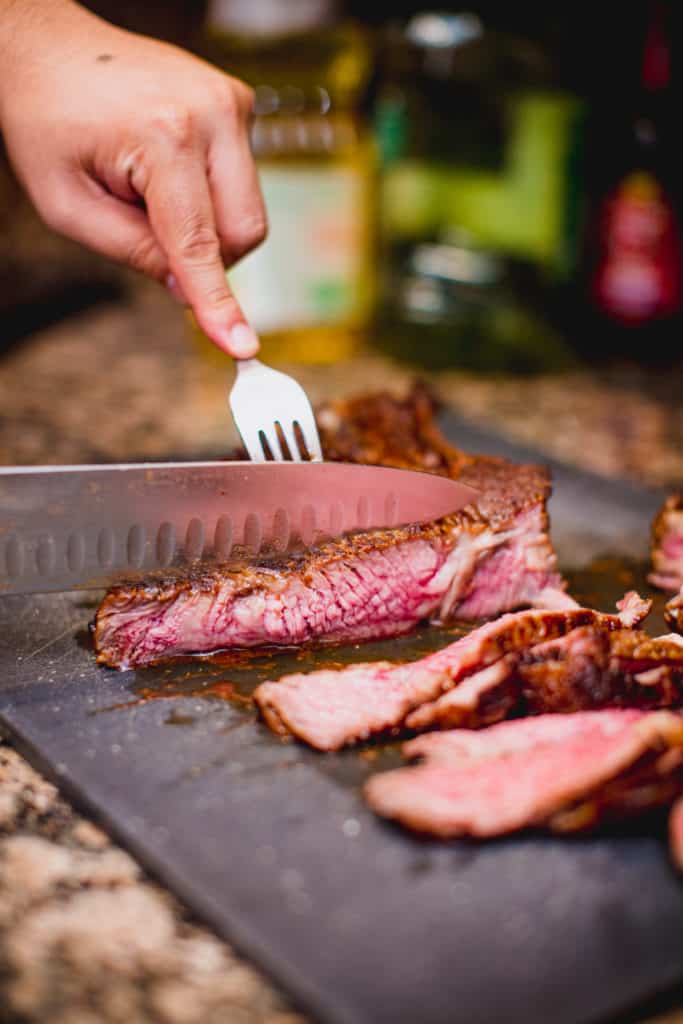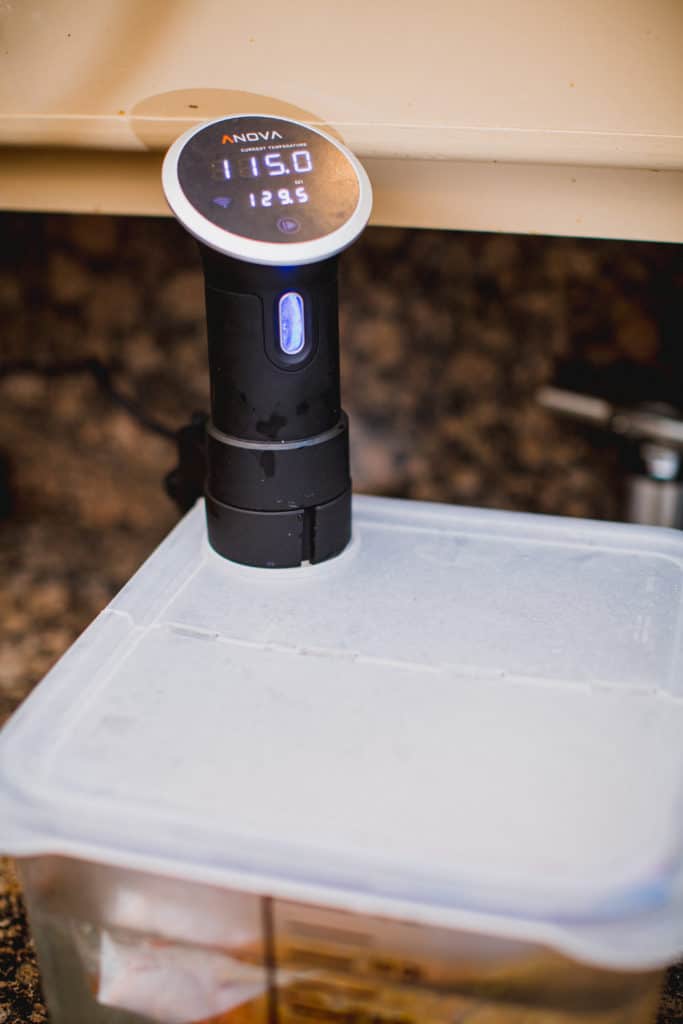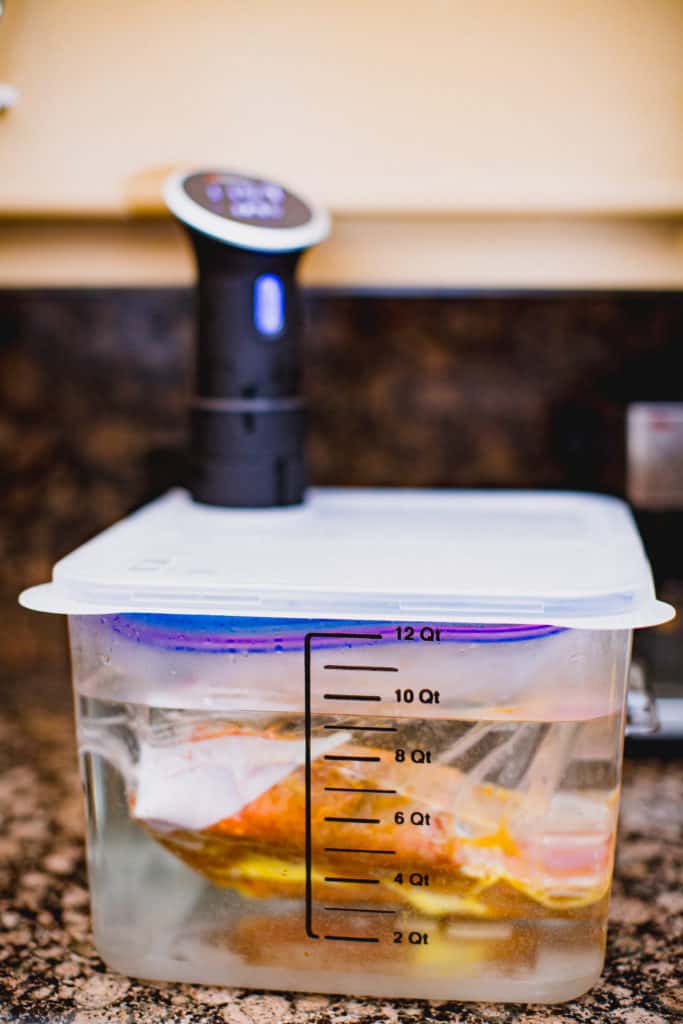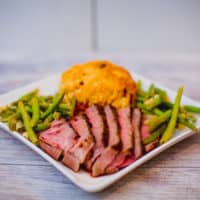As an Amazon Associate we earn from qualifying purchases.
Ribeye steak and sous vide were seemingly made for each other. All the benefits that the sous vide brings to the table work so perfectly with a ribeye steak. If you like juicy steaks, there is no better way than sous vide steak recipes.
Quick Navigation
Picking the Perfect Steak for the Sous Vide
I really like ribeye steak for sous vide. You may know them as cowboy steaks, tomahawk steaks, prime rib, or rib roasts (they are all pretty much the same cut).

I generally avoid bone-in steaks when using traditional cooking methods because the bone has a higher specific heat than the meat, requiring more cook time. Since I am using my temperature controlled sous vide method, I can get all that great flavor and texture from the bone meat and I won’t risk over cooking my food.
The other major benefit of bone-in steaks is they are cheaper and have more meat on them. I got a USDA Choice 2.72 pound steak, normally $40 for just $13.50! That is $2-3 per pound cheaper than the boneless ones.
Also, when picking steaks you generally want thicker cuts. A thicker cut means more middle. I like my sous vide steaks between 1.5 and 2.5 inches tall. If you don’t see any thick cuts, ask the butcher behind the counter, and most stores will custom cut one for you at no charge (my sous vide steak was custom cut).
That said, a sous vide is actually really perfect for thin cuts too since there is no chance of overcooking.
What is a Sous Vide?
Sous vide, French for “under vacuum,” is the process of slowly cooking sealed food in a water bath at a controlled temperature. You may have also heard this called precision cooking.
The beauty of the sous vide process is that your food will never exceed the temperature of the water you put it in. That said, it is basically impossible to overcook your food.
How Does Sous Vide Cooking Work?
First, let’s understand the sous vide bath. Every substance has something called specific heat. This roughly translates into how much energy it takes to heat something and how much heat energy that thing will then store.
Aluminium has a low specific heat, which means it heats fast and also loses heat fast. This is why you can touch a sheet of foil moments after it comes out of the oven.

Water, on the other hand, has a really high specific heat, this is why it takes forever to get a pot of water to boil. Also if you turn off the stove, that boiling water will be hot for a long time. Cooking in a water bath works because water is really great at moving and storing heat.
Understanding Thermodynamics
Next, let’s talk about thermodynamics in simple terms. When I cook anything, heat wants to travel from things that have warmth to things that don’t. As a basic visual equation, think of it this way:
Hot pan + cold food going onto that hot pan = hot food
When I think of how heat travels within my food (from the outside to the inside), it is the same process. This is where I get the idea of doneness.
Steak is the perfect illustration of doneness. Cook a steak on a hot grill, in a pan, or in your oven, and you will get varying doneness. This is because the cooking vessel is hotter than you want the sous vide steak to be.
For example, if you were grilling a steak at 450°F, the outside of the steak will be at 450°F (that is how you get grill marks). That means your steak will be well done at the outside, to medium-well, to medium rare, or to wherever you stopped cooking.
That gradient of doneness from medium rare or brown to pink is because the outside of the steak is the hottest, and the inside is the coolest.

The problem with high-heat cooking is the heat applied to the outside of the meat is way higher than what you want the inside to be at. Using a water bath set to the temperature you want the inside done at, you can bring the whole steak up to medium rare without overcooking any part of it.
Even if you wanted a well-done steak instead of a medium rare steak, this method would ensure no part of your steak is overcooked.
What Doesn’t a Sous Vide Do?
In reading this, you might think that this method equals perfect ribeye steaks, and you would be half right. The temperature and doneness is only part of the equation when cooking (especially with meats).
What sous vide cooking doesn’t do is brown. That means no grill marks, and no tasty crust or crunch. Sous vide food may be the perfect temperature, but the taste and texture won’t be there.
Avid readers of my blog will be familiar with the concept of Maillard Browning a.k.a the Maillard Reaction. The Maillard Reaction occurs right around 300°F and is what helps give browned food their distinctive flavors. Since I’m only cooking at low temperatures, this process will never happen.
Two Phase Cooking
To get your food to the right texture and overall flavor on your sous vide ribeye steak, you’d be cooking steak in two phases:
- Phase 1: Cook the sous vide ribeye steak through to the desired temperature
- Phase 2: In a searing pan, broiler, or grill as fast as possible to brown the outside of the sous vide ribeye steak
Developing Flavors
I have left this sous vide steak recipe very basic, so you can add and subtract to it as you wish. As a general rule of thumb, do not add herbs on the surface of the ribeye in high-heat cooking because they will burn. All spices of a seasoned steak benefit from additional fat like butter to transfer their flavors because they are mostly oil-based. Some of my favorite additions are:
- Thyme in the butter when you sear it: this is the most common prep you will see in videos online
- Rosemary: fairly common during the holidays
- Freshly ground black pepper
- Blackened spices like paprika or cayenne added before the sear
Tools Required

There are very few tools you need in addition for this sous vide ribeye recipe:
- Sous Vide Machine or Precision Cooker (I love mine from Anova)
- 12+ quart tub or large stock pot for water
- Heavy freezer or a sous vide bag
- Something to sear with (cast iron skillet, broiler, grill, blow torch)

Ingredients
- 1 bone in rib eye 1.5+ inches thick
- 1 tablespoon salt
- 1 tablespoon pepper
- 4 tablespoons butter (2 tablespoons butter for the sous vide 2 tablespoons butter for the sear)
- 8 quarts water
Instructions
- Set your sous vide to 129°F
- Fill your tub with about 8 quarts of water
- Mix your seasonings together – in our case, salt and pepper
- Season all sides of the ribeye liberally
- Place the steak into a heavy-duty freezer bag or sous vide bags
- Place 2 tablespoons butter into the bag (1 tablespoons per side)
- Without letting water into the bag, submerge it into water to force the air out around the steak and seal the bag and set aside
- When your sous vide comes up to temperature, place steak in and cook for at least 1.5 hours
- Remove steak from bag and pat dry with paper towels
- Heat a pan, oven, or grill as hot as it can get
- Add 2 tablespoons butter
- Sear both sides of the steak for 1 minute per side
- Serve
